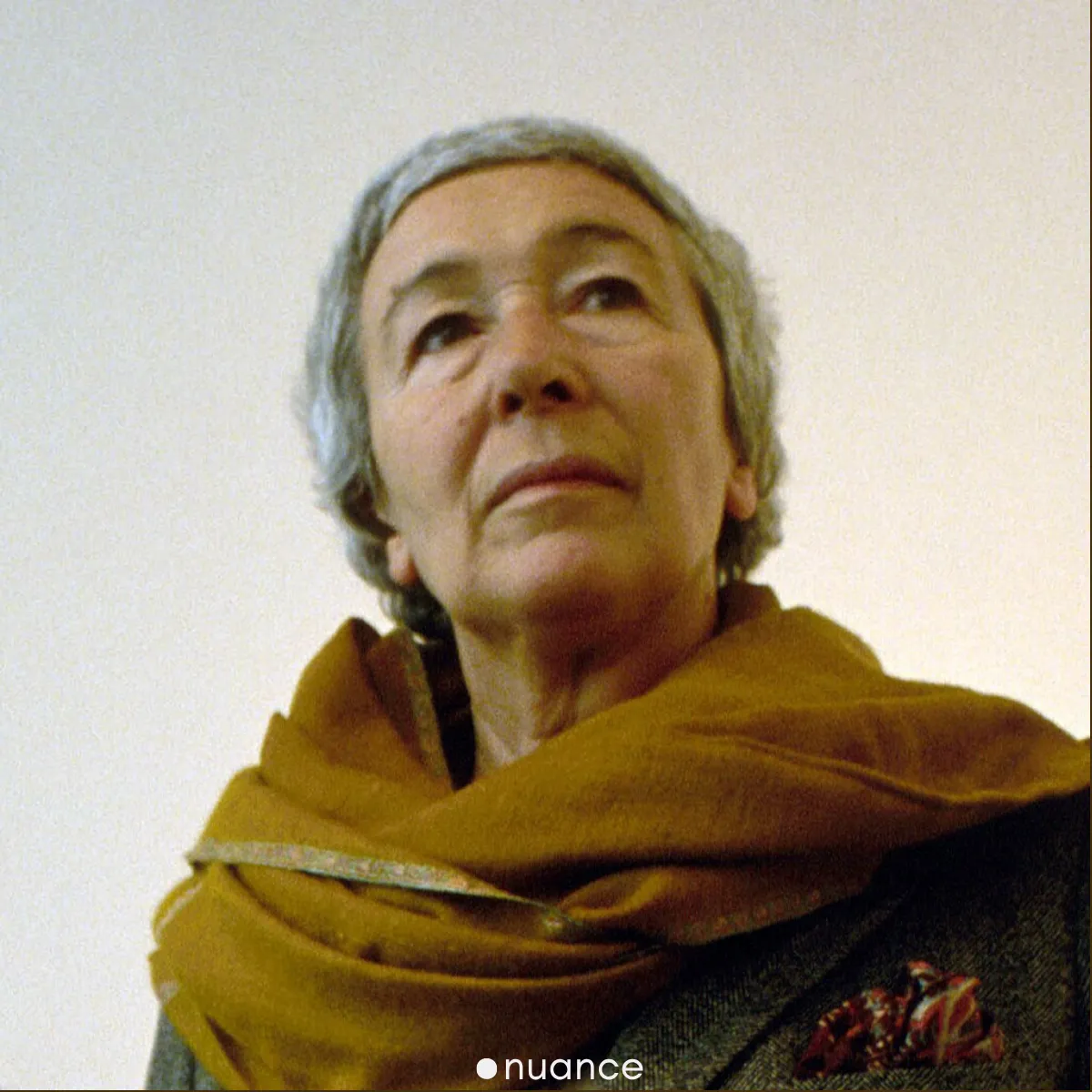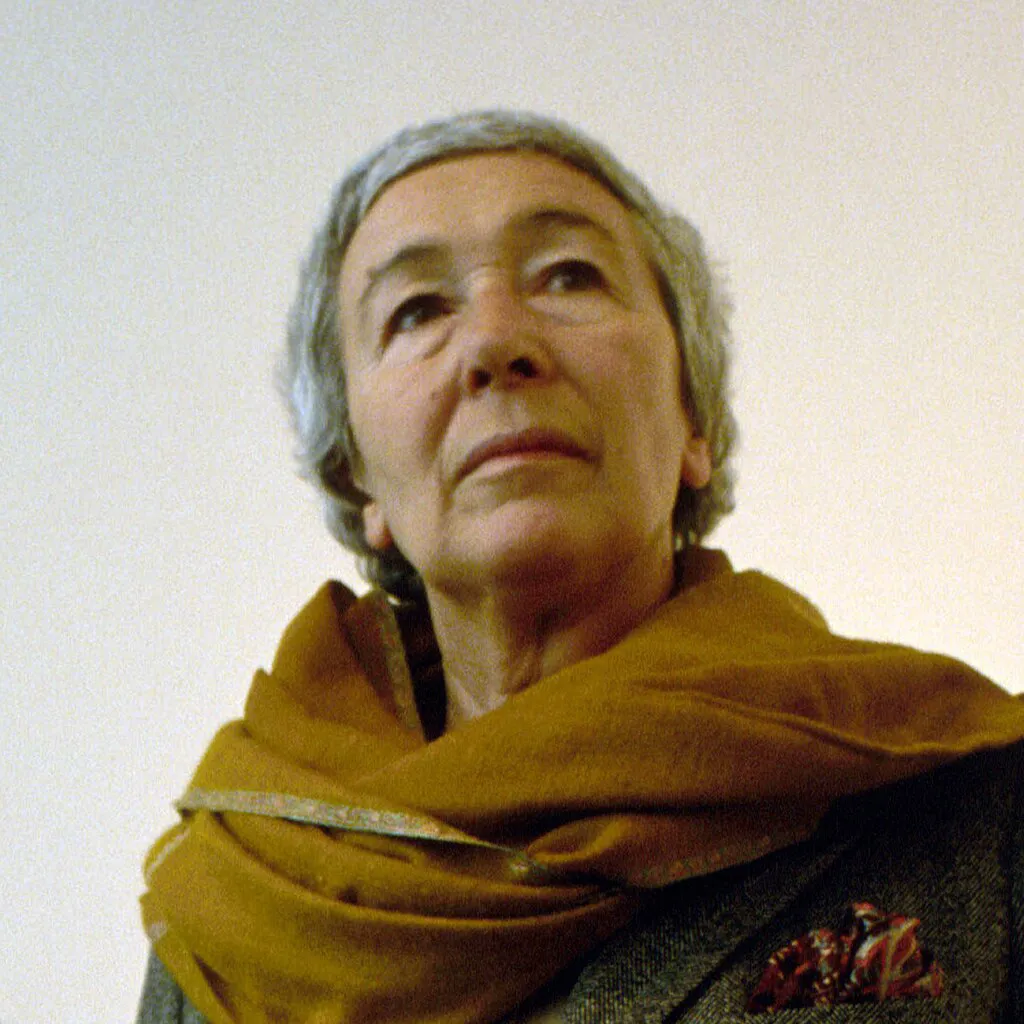Gae Aulenti, the Designer Who Could Do It All
If you know one Aulenti design, it’s probably the Pipistrello Lamp (1965). A telescoping, mushroom-like piece that’s as much sculpture as lighting.
She designed for Knoll. She made furniture that felt like mini architecture – tables with column-like bases, lamps that played with shadow and glow. Always Timeless. Never chasing trends.
Gae Aulenti (Gaetana Aulenti) was born in 1927 in a tiny town in northeastern Italy. Aulenti decided – against her parents’ wishes – to study architecture.
She later described as an act of rebellion.
She graduated from the Politecnico di Milano in 1953, one of only two women in her class of twenty. She didn’t try to prove herself by being louder or bolder. She proved herself by listening. To the building, to the city, to the poeple who would use space.
Early in her career, she joined the influential design magazine “Casabella” under editor Ernesto Nathan Rogers, an experiance that profoundly shaped her architectural philosophy.
She didn’t start small, she went straight into creating pieces that would become icons. The tubular Locus Solus outdoor furniture, the telescoping Pipistrello Lamps, and the unapologetically chanky marble Jumbo coffee table.
Design Philosphy and Style
Aulenti’s design philosophy was deeply rooted in context, history and multidisciplinary approach.
She believed that modern design should engage with historical “pre-existence” – the cultural and environmental context of place – rather than impose a homogenized international style.
This perspective led her to create designs that dialogue with their surroundings. In architecture she often juxtaposed new structures and old settings, while in product design she mixed traditional forms with modern materials.
Tradition is not static legacy but something one actively builds every day.
Another hallmark of Aulenti’s philosphy was the integration of diverse design fields. She saw architecture as encompassing interior design, indutrial design, exhibition design, and even theatrical design in a continuous spectrum of the built environment.
The Musée d’Orsay
Today, “adaptive reuse” sounds a buzzword in sustainable architecture. In the ’80s? Not so much. But Aulenti was already proving that you could take a forgotten building and make it relevant without erasing its soul.
If you’ve ever been to Paris and wandered into the Musée d’Orsay, you’ve seen Aulenti at her most brilliant. She took the Paris’s Gare d’Orsay train station – grand, ornate, completely impractical for exhibitions – and yet turned into light-filled musem for 19th century art.
Auelnti’s design kept its iron & glass drama intact, than built smaller human-scaled galleris indside. She left the gaint clock where it was and turned the central nave into this glorious, light-filled sculpture hall. The result? A transformative museum design that brought her worldwide acclaim.
She pulled of similar magic at Venice’s Palazzo Grassi, Barcelona’s Museu Nacional d’Art de Catalunya, Rome’s Scuderie del Quirinale and even San Francisco’s Asian Art Museum.
As I mentioned before, she was the queen of adaptive reuse long before the term was trandy. Her formula?
Respect the building’s history, but don’t be afraid to leave your own fingerprint.
product design
Pipistrello lamp (1965)
Pipistrello (Italian for “bat”) lamp (1965) is still in production, still gorgeous. Her best known product design. That telescopic base, and a flared white acrylic shade reminiscent of a bat’s wing. She created it for te innovative lighting brand Matinelli Luca. it feels modern but also retro and yet elegant an enduring icon of modern lighting.

King Sun (1967)
Designed for the Olivetti showroom in Buenos Aires, a space Aulenti herself turned into a kind of indoor “piazza”, complete with sweeping curved stairs. The mirrored ceiling and walls enhanced the kaleidoscopicall aesthetic. where their reflections multiplying endlessly.
The King Sun is a vivid red-orange base, ringed with semi-circular clear acrylic “fins”. The bulb sits in the center so when it’s on, the light spills through the fins, outlining their edges in a warm, glowing halo.
It’s Pop Art meets technical brilliance.
Giova Lamp (1964)
The Giova Lamp for FontanaArte is another classic, a light source, a sculptural object and a functional vase. And a perfect example pf Aulenti’s philosophy of multi-finctional design. This dual purpose approach became a hallmark of her thinking. Objects should serve multiple roles while keeping their aesthetic integrity.
It is still in production by FontanaArte, in both small and large sizes, proof that a clever, beautiful idea can outlast decades of shifting trends.
Sgarsul Rocking Chair (1962)
The Sgarsul rocking chair (1962) her first piece. The name means “slacker” in italian dialect, because She’d give it a cheeky twist. It’s bentwood, flowing, almost exaggerated. Funky, yet functional. Very 60s Italy, but also timeless in its curves.
Stringa Sofa (1963)
The next year she created the Stringa sofa (1963). A low, modular design with a metal frame and swappable cuishion. Modern. Informal. Made for real living, not for showrooms.
Locus Solus (1964)
1964, she brought out the Locus Solus series for Poltronova. Tubular metal frames, bright finishes, indoor-outdoor versatility. Chairs, chaises, tables, light and playful, but sturdy.
The same year, she designed the Aprilina folding chair for Zanotta. All aluminium, light enough to carry in one hand. Later, in 1970, she beefed it into the April chair with a matching foortrest.
Jumbo coffe table (1965)
Then there is the big one. The Jumbo Coffee table (1965). A massive block of marble, low and unapologetically heavy.
Called as an “essentially a miniatura monument”.
Again, the Jumbo table’s monolithic appearence and polished stone finish reveal Aulenti’s architectural sensibility apllied to furniture. It’s constructed with precise geometry and makes a statement in any room.
Even though, Aulenti design the table in 1965, it was only inturduced commercially in 1972 by Knoll.
Tavolo con ruote (1965)
In 1980, she flipped the script with the Tavolo con Ruote, a heavy sheet of glass resting on four industrial caster wheels. Born from an exhibition project, now in the MoMa collection. It is witty, minimal and weirdly practical – you can just roll it across the room.
What makes Aulenti’s work timeless is her attitude. She didn’t chase trends, actually she kinda avoided them. If red was in, she’d go green. She believed in designing for a specific place, a specific purpose.
And let’s not forget, she was a woman making her mark in a male-dominated field. She didn’t just join the conversation, she rewrote it.
Gae Aulenti’s influence on contemporary design and architecture is profound and enduring. As a pioneering woman in postwar architecture and design, her presence and success broke barries – she showed that woman can lead major international projects, run a design office and define her own aesthetic in a field traditionally dominated by men.




